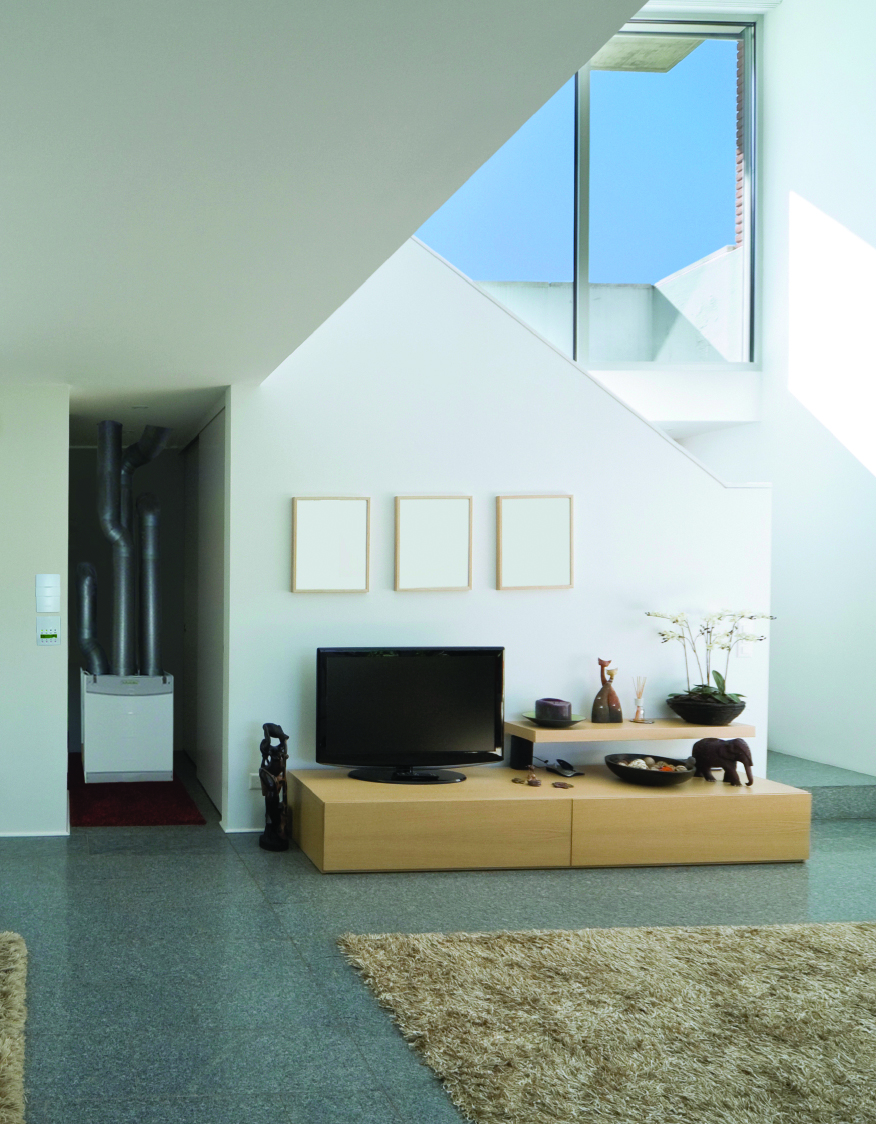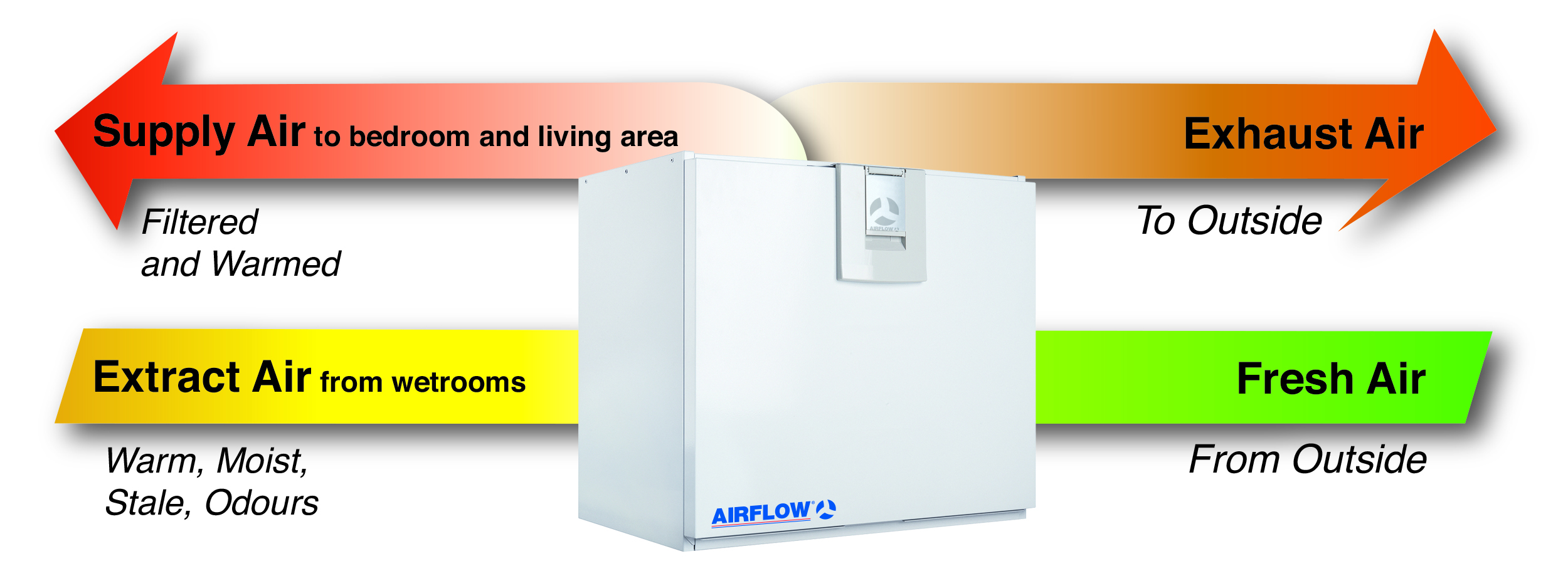By Sophie Neaves on Fri 21 July 2023
Understanding MVHR cooling

MVHR may stand for mechanical ventilation with heat recovery, but it can also help you cool a building down. Even in the UK, there’s a very real need for cooling systems in our buildings, not least because our summers are gradually getting hotter.
With this increasing demand for cooling in mind, let’s examine how MVHR can cool buildings down.
How does MVHR cooling work?
To understand how MVHR cooling works, you first need to know what heat recovery is and how it works in MVHR systems.
Heat recovery is the practice of retaining heat that would otherwise be lost as it exits a building. In MVHR systems, this outgoing heat is found in the stale air extracted from the building using fans. The air is passed through a plate heat exchanger, where the heat from the outgoing air is transferred to fresh air entering the building from outside. This incoming air passes through filters that remove impurities before collecting the heat and being distributed around the building.
This is an extremely efficient way to ventilate and contribute to heating a building in the winter, but preserving heat isn’t desirable in the warmer months. So, many MVHR units come with a summer bypass, which diverts incoming air away from the heat exchanger and directs this cooler air straight into the rooms being supplied with fresh air. Some summer bypass systems include sensors that detect when higher temperatures inside mean heating isn’t needed and automatically engage the bypass function. Additionally on some more advanced MVHR units a partial bypass is utilised, where the unit will recover some heat and combine it with the cooler air, ideal for the spring and autumn months.
Importantly, it’s humid air that MVHR removes from kitchens, bathrooms, utility rooms and other ‘wet’ rooms. Humid air makes us feel warmer than less humid air, even if both are the same temperature. So, by lowering the relative humidity, MVHR helps you feel cooler. Also, by removing excess humidity it ensures there is no mould build up in the wet rooms, which can have a negative effect on the occupants health, triggering allergies and skin disorders.

Proactive MVHR cooling
MVHR and similar systems work best when a building is airtight, which makes it much harder for heat to escape. Again, this feature is much more desirable in the winter than the summer. It can also mean that some buildings need a more proactive method of cooling than a straightforward summer bypass.
A ground source temperature collector is one such method. It taps into the lower temperatures found around 1.2m underneath the ground, which are between 8°C to 12°C.
In a brine-to-air energy collector, a hydraulic pump circulates a solution of brine and antifreeze through underground piping. This solution becomes cooler and is then transferred to the MVHR system’s heat exchange unit, where it’s used to cool the incoming air.
Other methods of cooling used by MVHR systems include chilled water cooling coils and direct expansion (or DX) coils. A DX coil works by pumping a refrigerant through a cooling coil, which is essentially another type of heat exchanger. The refrigerant absorbs heat from air passing the coil before heading to a compressor for pressurisation and cooling. Then it’s allowed to expand and provide cooled air to the building.
Plus, MVHR can recover cooled air, just as it does warm air. When an active cooling system (such as air conditioning) is in use, MVHR will recover the cooled air, reducing the load on the active cooling system.
MVHR vs air con
First of all, it’s important to note that MVHR will never cool as powerfully as air conditioning can. For MVHR cooling to actually make a difference, the system must be capable of moving around double the volume of air that a regular MVHR can. It’s upgrading the MVHR to do that quietly is where most of the cost comes in.
However, MVHR units are extremely effective at maintaining a constant temperature, so regulating the temperature early will result in a cooler building.
Plus, unlike air conditioning, MVHR gives you freshly filtered air, rather than just recirculating stale air. Indeed, at the height of the Covid–19 pandemic, the UK government asked people to refrain from using systems that simply recirculate air – to reduce the spread of the virus. When it comes to the health of occupants, MVHR is a far superior option than air conditioning.
And there are several other advantages that MVHR holds over air conditioning. These include lower levels of noise, lower energy usage and, potentially, lower running costs.
What are the benefits of cooling MVHR?
With temperatures increasing around the globe, the threat of buildings overheating is rising. Parts of the world that never had to consider the problem are now having to adapt, whether it’s caused by high-rise offices/homes, unshaded glazing, or the building’s orientation. By engaging a summer bypass or through more proactive measures, MVHR can combat overheating.
It can also save energy at the same time. Air conditioners use more electricity than any other household appliance and, combined with electrical fans, consume 10% of global electricity. Since MVHR systems don’t need to use such high levels of energy, they offer both environmental and financial benefits.
MVHR is also a much healthier way to cool a building than air conditioning – because there’s a constant of fresh air. Air conditioning, on the other hand, simply pumps out the same stale air, at a cooler temperature.
Plus, centralised MVHR can cool a whole building, whereas air con covers just those rooms with an air con unit. These units normally have a dedicated fan motor, causing noise wherever air con is in use. By contrast, motors for MVHR systems will only be part of the centralised unit and won’t be present in each room.
And there are many more reasons why MVHR systems are increasingly popular: here are more benefits of installing an MVHR system.
What are the advantages of having good indoor air quality?
The Covid-19 pandemic opened many eyes to the importance of indoor air quality and led to governments taking action on it.
But it’s not just virus transmission that comes as a consequence of poorly ventilated buildings. When pollutants are allowed to proliferate inside and fresh air isn’t regularly introduced, all manner of conditions can arise or become exacerbated. These include everything from allergies and respiratory problems like asthma, to heart disease and strokes.
Everyday health also improves with good air quality. In schools, colleges and universities, the reduction of CO2 levels helps students to concentrate. The same is true in offices, where good air quality helps to limit staff absence through viruses and other illnesses.
Plus, with proper ventilation, the potential for mould and damp problems is greatly reduced, eliminating a major source of respiratory issues. Of course, preventing mould and damp from taking hold also helps to safeguard the structural fabric of a building.
When should you choose to install MVHR?
Buildings of all shapes and functions can benefit from MVHR systems, particularly with today’s high energy costs and shifting climates.
However, it should be noted that it’s always best – whenever possible – to include MVHR systems in initial blueprints for a building. It should form part of architects’ plans for mitigating the risk of overheating – alongside measures such as carefully chosen building orientation, shading for windows and selecting the most appropriate building materials.
As part of an integrated and comprehensive building design, MVHR can provide extremely efficient cooling. As developers and homeowners around the world look for more sustainable solutions, its cooling credentials only add to the appeal of MVHR.